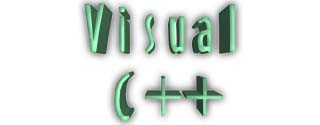
The Visual C++ Programming Language
Click below to go directly to a specific section:
History |
Significant Language Features |
Areas of Application |
Sample Programs
Related Links |
Printed References |
Acknowledgements
History
As the Microsoft Windows and the benefits of the graphical
user interface (GUI) became widely accepted, the programming
for Windows became in high demand. Programming for Windows
is different from old-style batch or transaction-oriented programming.
An essential difference between them is that a Windows program processes
user input via messages from the operating system, while an MS-DOS
program calls the operating system to get user input.
Visual C++ is a textual language which uses a graphical
user interface builder to make programming decent
interfaces easier on the programmer.
Significant Language Features
C++ is one of the components of Visual C++. However, its compiler can
process both C source code and C++ source code. Further more, the version
4.0 compiles Fortran code as well.
Visual C++ also includes a large and elaborate collection of software
development tools, all used through a windowed interface.
The Microsoft Visual C++
includes the tools listed below.
- Microsoft Foundation Classes (MFC)
A large and extensive C++ class hierarchy library that
make the Windows application development easier.
- App Wizard
A code generator that creates a working skeleton of a Windows
application with features, class names, and source code filenames.
It gets a programmer started quickly with a new application.
- Class Wizard
A program which generates code for a new class or a new function.
It writes the prototypes, function bodies, and code to connect the
messages to the application framework.
- App Studio
A resource editor which includes wysiwyg menu editor and a powerful
dialog box editor.
Areas of Application
- Windows application development
Sample Programs
Related Links
Printed References
- Kruglinski, David J. (1993). Inside Visual C++. Microsoft Press.
- Barkakati, Nabajyoti (1995). Visual C++2 Developer's Guide Second Edition. Sams Publishing.
- Murray, William H. and Pappas, Chris H. (1995). The Visual C++ Handbook Second Edition. Osborne.
Acknowledgements
Credit should be given to
the Hello, World! program written in Visual C++ and submitted by
Paul Roub, which I created my Hello world! program based on. Also, credit should be given
to the book "Inside Visual C++" written by David J. Kruglinski for a clear description of
Visual C++ and its components to which I referred on creating this web page.
![[Prev]](../prev_btn.gif)
![[Home]](../home_btn.gif)
![[NEXT]](../next_btn.gif)
Last modified: 07:30 PM on 11/21/1996
This page has been accessed


![[Prev]](../prev_btn.gif)
![[Home]](../home_btn.gif)
![[NEXT]](../next_btn.gif)